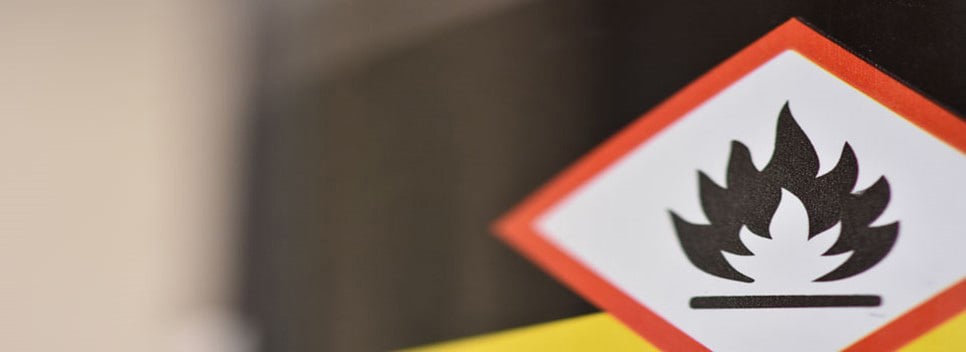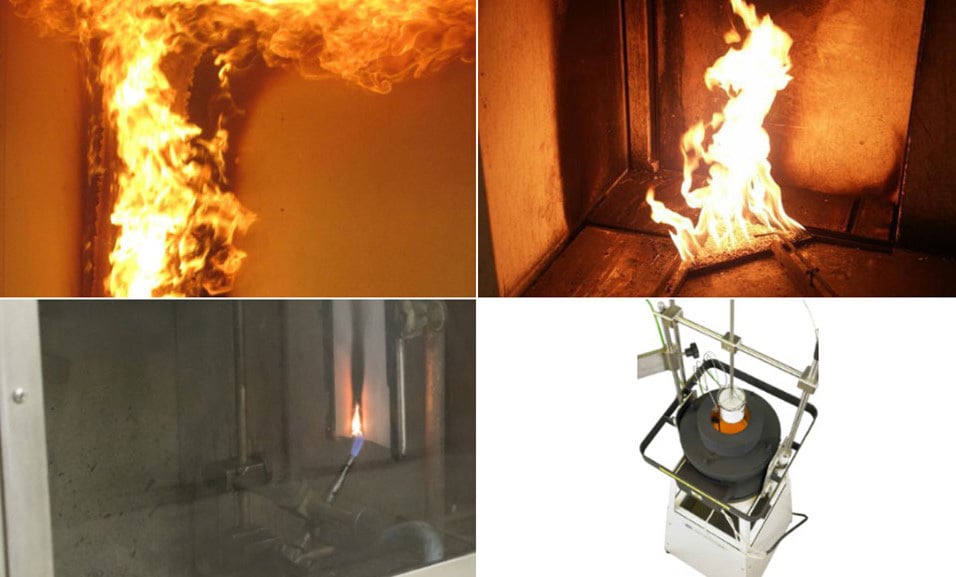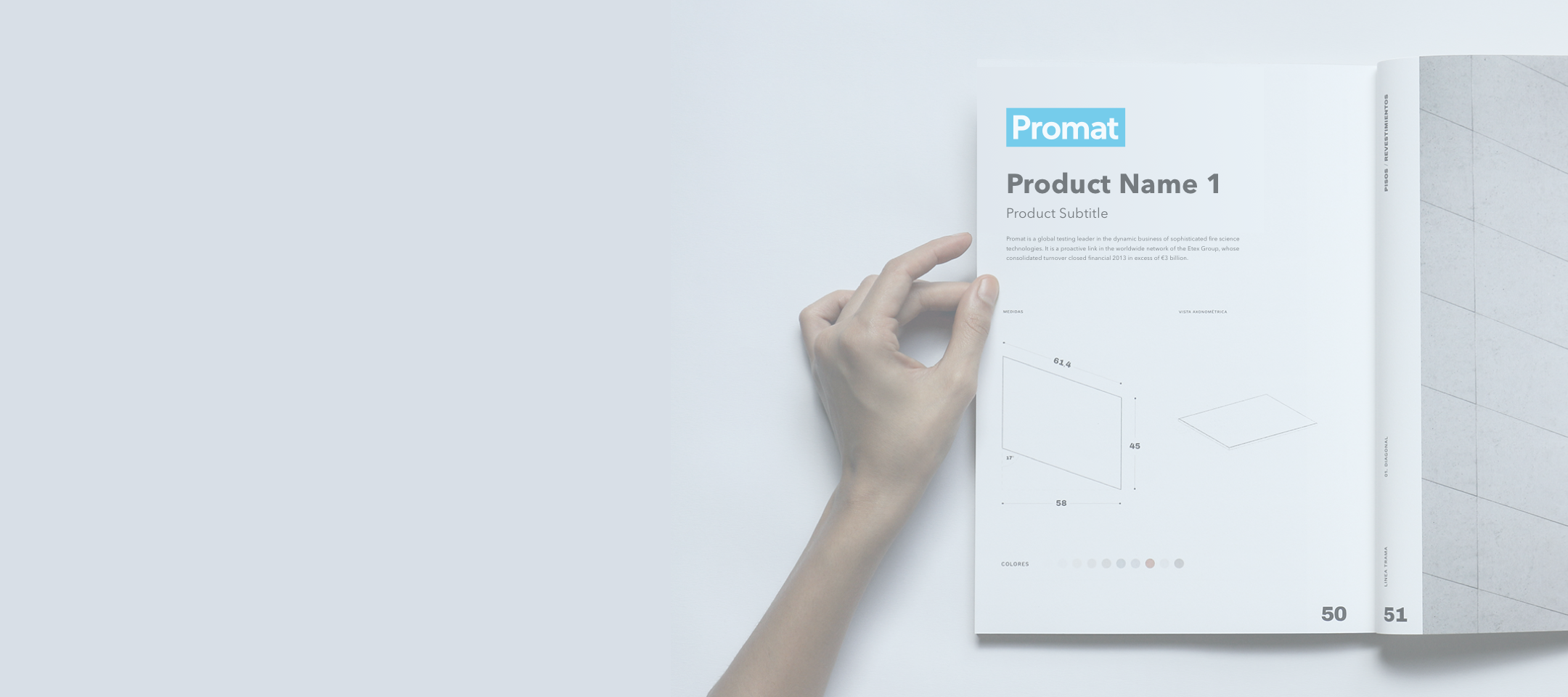
The fire safety of construction sites and buildings depends heavily on the types of materials used. Almost all building materials and furnishings contribute to the so-called fire load. The intensity, the nature of the heat flow, the duration and the temperature reached by a fire are a consequence of the fire load and the heat release rate, which considers the aggregate properties of materials used in the construction of the building. The materials are conventionally divided into combustible substances and non-combustible materials. This classification will be discussed in more detail in what follows.
Combustibility of materials and test methods
Standard EN 13501-1 ‘Fire classification of construction products and building elements (Part 1: Classification using data from reaction to fire tests)’ aims at defining a harmonised approach to classifying the fire reactions of construction products (including products incorporated within building elements) under the Euroclass system. Products are considered in relation to their end-use application and are divided into three separate categories:
- construction products (excluding floorings and linear pipe thermal insulation products)
- floorings
- linear pipe thermal insulation products (excluded in this article)
Electrical cables are classified in terms of different test and classification standards.
EN 13501-1 also specifies test methods classified in relation to the envisioned reaction to fire, while each method further describes the principles of testing, specimen preparation and minimum number of tests. The following test methods are used for evaluation of the reaction of materials to fire:
- Non-combustibility test (EN ISO 1182): This test determines the non-combustibility of homogeneous building materials.
- Heat of combustion test (EN ISO 1716): When tested by this method, a certain mass of the sample material burns under standardised conditions. Combustion heat or calorific value is calculated on the basis of the measured temperature rise, heat losses being taken into account.
- Single burning item (SBI) test (EN 13823): This test simulates the burning of one object (such as a basket) in a corner of a room where the material to be tested is placed. As far as possible, the product should be tested in its end-use form.
- Ignitability test (EN ISO 11925-2): This test determines the possibility of igniting vertically suspended building material when exposed to a direct burner at an angle of 45 degrees.
- Determination of the burning behavior of floorings, using a radiant heat source (EN ISO 9239-1): This method measures the value of critical heat radiation, that is, the incident heat flux at the surface of the floor covering where the flames stop advancing and can be extinguished.

Construction products classifications
Building materials are classified as non-combustible and combustible. The classification takes into account the contribution to the development of a fire before the flashover and the contribution to the fire load of a room in a fully developed fire.
‘Non-combustible’ building materials are those which, under the prescribed test conditions, cannot burn or contribute to the development of a fire. These are, according to the EN 13501-1 qualification, class A1 and A2 materials.
Note that a material A2, even if not literally ‘not combustible ’, is classified in the same ‘macro-class ’ as A1 because the contribution to the fire development and to the heat release is extremely limited.
‘Combustible’ building materials are those which ignite under the prescribed test conditions. In consideration of their contribution to the development of a fire, combustible materials are divided into flammable (B and C), normally flammable (D and E) and highly flammable (F).
- Class F - Material without specified fire performance or products that do not meet the criteria for Class E. In some countries the installation of these materials is not permitted unless they are fully covered with other building materials, so that the whole product is classified as at least Class E. Examples include expanded polystyrene and polyurethane, both without flame retardants.
- Class E – Material that resists low flame ignition for a short period of time and does not produce a large flame spread. Examples include soft fiberboard as well as expanded polystyrene and polyurethane, both with flame retardants.
- Class D – Material that meets the criteria for class E but resists low flame ignition for a long time and does not result in a significant flame spread. Even with the Single Burning Item (SBI) test, heat release is slowed and limited. Examples include different types of wood, and wood products.
- Class C - The same as Class D, except that the material meets higher requirements and there is no flame spread in the SBI test. Examples include phenolic foam and sandwich panels with polyurethane foam.
- Class B - The same as Class C, except that the material meets higher criteria. Examples include wood-cement panels, wood panels treated with flame retardants, and sandwich panels with polyisocyanurate foam.
- Class A2 – Material that meets the same criteria as Class B and less severe criteria than A1. In a fully developed fire, this material does not increase the fire load or accelerate the spread of the fire. Examples include stone mineral wool sandwich panels and gypsum plasterboards.
- Class A1 - At no stage of the fire, even in a fully developed fire, does the material promote the spread of the fire or does it increase the fire load. Examples include stone, brick, metals, inorganic materials with less than one percent of organic matter, and mineral fiber insulation products.
Floorings are classified according to the same classes as construction products but are tested horizontally. The classification letters are followed by the ‘fl ’ abbreviation (e.g., A1fl).
The following table sums up the different product categories, test methods and combustibility classes:
| Classification according to EN 13501-1 | ||||||
| Definition | Test method | Construction products | Floorings | |||
| Non-combustible materials | Non-combustibility test and heat of combustion test | A1 | A1fl | |||
| Non-combustibility test or heat of combustion test and SBI |
A2 – s1 d0 A2 – s2 d0 A2 – s3 d0 |
A2 – s1 d1 A2 – s2 d1 A2 – s3 d1 |
A2 – s1 d2 A2 – s2 d2 A2 – s3 d2 |
A2fl – s1 | A2fl – s2 | |
| Combustible materials – very limited contribution to fire | Ignitability test and SBI test |
B – s1 d0 B – s2 d0 B – s3 d0 |
B – s1 d1 B – s2 d1 B – s3 d1 |
B – s1 d2 B – s2 d2 B – s3 d2 |
Bfl – s1 | Bfl – s2 |
| Combustible materials – limited contribution to fire |
C – s1 d0 C – s2 d0 C – s3 d0 |
C – s1 d1 C – s2 d1 C – s3 d1 |
C – s1 d2 C – s2 d2 C – s3 d2 |
Cfl – s1 | Cfl – s2 | |
| Combustible materials – medium contribution to fire |
D – s1 d0 D – s2 d0 D – s3 d0 |
D – s1 d1 D – s2 d1 D – s3 d1 |
D – s1 d2 D – s2 d2 D – s3 d2 |
Dfl – s1 | Dfl – s2 | |
| Combustible materials – high contribution to fire | Ignitability test | E | E - d2 | Efl | ||
| Combustible materials –easily flammable | F | Ffl | ||||
Additional classifications
In addition to the basic letter designations for combustibility (A1, A2, B, C, D, E and F), building materials need additional classifications regarding the emission of smoke and the production of flaming droplets and/or particles. These classifications are the following:
- ‘s’ smoke emission level – specifies the speed of smoke release and the total amount of smoke generated, with values ranging from 1 (absent/poor) to 3 (high)
- ‘d’ flaming droplets and/or particles production – specifies the formation of burning droplets during the reaction to fire tests, with values ranging from 0 (absent) to 2 (high)
| Additional classification | Level | ||
| Smoke emission level during combustion | s | 1 | Absent or weak speed/quantity of emission |
| 2 | Average intensity of speed/quantity of emission | ||
| 3 | High intensity speed/quantity of emission | ||
| Flaming droplets and/or particles production during combustion | d | 0 | No dripping |
| 1 | Slow dripping | ||
| 2 | High dripping | ||
Subclass d2 is provided only for classification E.
Conclusion: When are combustibility tests of building materials performed?
For most buildings, pre-construction by definition involves obtaining various permits, the same goes for restorations, extensions, technical re-equipment of buildings, repairs and other activities. Sometimes a certain type of building requires additional fire examination and this issue is regulated by law. This includes the assessment of building materials for ignitability, combustibility, etc. That is, a change in the functional purpose of the structure is also a sufficient reason for the study of building materials, and, if necessary, the designation of another class of fire.

